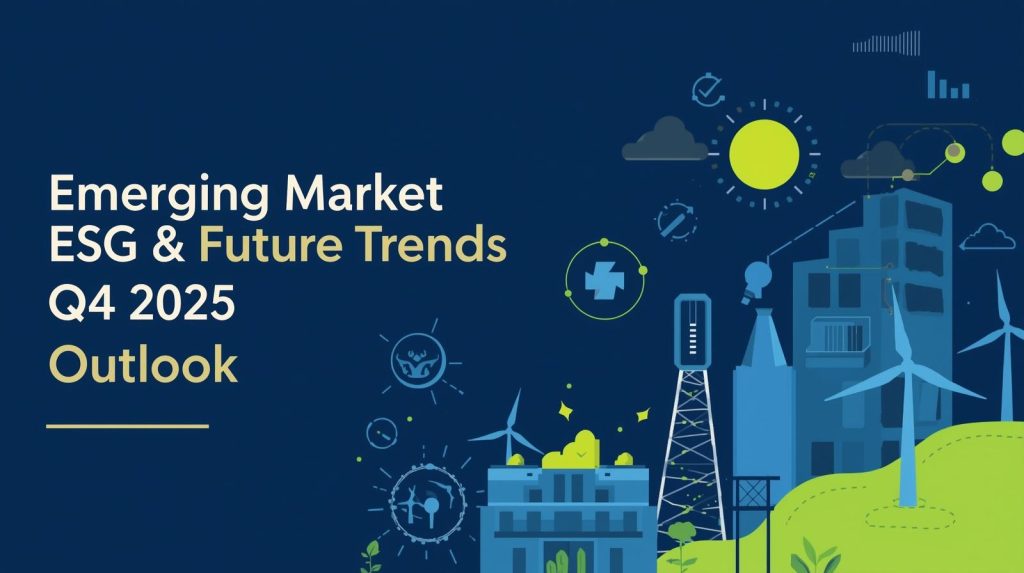
Introduction: ESG at a Crossroads in Emerging Markets
Environmental, Social, and Governance (ESG) investing is no longer a niche concept in emerging markets (EM). By Q4 2025, ESG integration has shifted from being a voluntary “good-to-have” feature to a critical determinant of capital flows, credit ratings, and investor perception.
Investors face a paradox: demand for sustainable investments in EM has never been higher, yet challenges such as inconsistent disclosure, greenwashing, and political volatility complicate execution. At the same time, future-oriented trends—clean energy, digitalization, demographics, and supply chain transformation—are redefining the ESG landscape.
Global Momentum Behind ESG Capital Flows
- Green Bond Issuance: EM sovereigns and corporates issued record volumes in 2025, particularly in Asia and Latin America.
- Institutional Allocations: European pension funds and U.S. asset managers increased allocations to EM ESG bonds, citing diversification and yield advantage.
- Policy Support: India’s 2070 net-zero plan, Brazil’s deforestation reduction policies, and Indonesia’s nickel ESG certification schemes drive new financing channels.
These dynamics ensure that ESG will remain a frontline driver of EM capital markets in Q4 2025 and beyond.
Thematic Crossovers: ESG + Future Trends
1. Clean Energy Transition
- India: Expanding solar and green hydrogen capacity.
- Brazil: Hydropower remains dominant, but solar/wind integration accelerating.
- South Africa: Renewable procurement auctions attract foreign capital.
Investor Angle: Green bonds tied to renewable projects yield 100–150bps over U.S. Treasuries, attractive for yield-hungry investors.
2. Digital & AI-Driven Growth
- Asia: Rise of data center REITs and AI infrastructure plays.
- LatAm: Fintech firms embedding ESG governance frameworks.
- Africa: Mobile banking improves financial inclusion, aligning with social ESG pillars.
Investor Angle: Digital ESG plays combine growth exposure with impact outcomes.
3. Demographics & Inclusion
- Africa: Youngest population in the world, fueling labor force expansion.
- South Asia: Rising middle class demands better healthcare and education.
Investor Angle: Blended finance models targeting healthcare/education generate stable social returns and measurable outcomes.
4. Sustainable Commodities
- Indonesia: Nickel ESG certifications crucial for EV supply chains.
- Chile & Peru: Copper and lithium exports tied to ESG compliance for EU and U.S. buyers.
- Brazil: Agricultural exports increasingly certified under sustainability standards.
Investor Angle: Commodity exporters without ESG alignment risk market exclusion.
Regional Spotlights
Asia
- India: Aggressive renewable expansion + digital financial inclusion.
- China: ESG momentum slowed by property sector drag, but state-linked green projects remain strong.
- Indonesia: Balances commodity exports with ESG-linked investment frameworks.
Latin America
- Brazil: Renewable powerhouse, significant ESG inflows into both public and private markets.
- Mexico: Strong in social bond issuance, particularly education and housing.
- Chile: Lithium exports tied to sustainability verification.
Africa
- South Africa: ESG bond issuance gaining traction, particularly for renewable projects.
- Kenya: Blended finance for social inclusion (education, microfinance).
- Nigeria: Potential but constrained by governance concerns.
Key Takeaways (Mid-Quarter Insights)
- ESG in EM is transitioning from optional to mandatory for international investors.
- Capital is flowing not only into “green” sectors but also into digital, demographic, and commodity-related themes.
- Selectivity matters: countries with clear ESG frameworks (India, Brazil, South Africa) attract inflows, while laggards risk higher borrowing costs.
Risk Scenarios for ESG Allocations in Q4 2025
- Greenwashing & Data Inconsistencies
- EM issuers may exaggerate sustainability credentials.
- Limited third-party verification undermines trust.
- Political Volatility
- Brazil’s fiscal debates and South Africa’s election cycle pose policy risks.
- ESG targets tied to political continuity (India, Indonesia).
- Global Standards Fragmentation
- Divergence between EU taxonomy, U.S. SEC rules, and Asian ESG disclosure frameworks complicates investor compliance.
- Commodity Dependence
- ESG funds face pressure when “green” commodities (nickel, lithium) are extracted in socially questionable conditions.
Investor Strategies for Q4 2025
Green Bonds as Core Allocation
- Continue to dominate EM ESG capital markets.
- Attractive yield spreads, especially from LatAm and Asia.
Thematic Equity & Fund Allocations
- AI & Digital ESG funds in Asia.
- Renewable infrastructure funds in LatAm and Africa.
Private Markets & Impact Investing
- Healthcare, education, and microfinance opportunities in Africa and South Asia.
- Blended finance allows risk-sharing with development banks.
Hedging Political & Policy Risks
- Diversification across regions (India + LatAm + Africa) mitigates concentration.
- Preference for issuers with consistent ESG reporting standards.
Case Studies
India: Green Hydrogen Leadership
- Flagship projects funded by sovereign green bonds.
- Targets global export markets.
Brazil: Agricultural Sustainability
- Soy exports increasingly linked to deforestation-free certifications.
- ESG compliance attracts European institutional investors.
South Africa: Renewable Auctions
- Private capital supports solar and wind projects.
- Power crisis creates urgency for investment.
Outlook Beyond Q4 2025
The future of EM ESG investing is not just about labels but about measurable impact:
- ESG will integrate with core future trends: digitalization, demographics, energy transition.
- Credibility will drive differentiation: countries with transparent ESG practices will enjoy lower borrowing costs and stronger capital inflows.
- By 2026, ESG investing in EM will evolve into mandatory allocation, not optional.
Leave a Reply